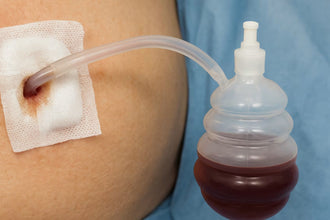Transitioning from Scar Tape to Silicone Scar Gel: When and Why?
If you've had surgery or an injury recently, you should know that how you treat your skin can really change how things look and feel down the line. Moreover, having a well-cared-for scar is usually more comfortable and brings fewer inconveniences in daily life.
There are a few popular ways to implement scar management, including silicone scar gels and tapes (read our comparison here). Both are really effective, but shifting from tape to gel as your scar gets better can actually help even more. But when to make the switch, and why even do it? Well, let's dive into that to get the most out of scar care.
A Bit About Scar Tape And Its Benefits
You've probably heard of scar tape. It's the long, uncut version of silicone sheets or strips, and they've been a go-to in scar care for a long time. It's flexible – like, really flexible - and it goes right onto your scar. Scar tape creates a sort of barrier, keeping moisture locked in and helping to smooth out and soften any bumps over time.
![]()
So, Why are Scar Tapes Good?
-
They Lock in Moisture: And don't underestimate this – scar tapes keep a just-right level of hydration on your scar, which keeps your skin happy and stops it from getting too dry or irritated. This means less collagen production, and a smaller chance of hypertrophic scars and keloids showing up.
-
Pressure and Compression: Scar tapes literally press down on the scar. This might sound strange at first, but it's actually really helpful. It remodels the collagen, which means a less raised scar over time.
-
No-Fuss Application: Ever heard of a no-brainer? That's silicone scar tape for you. Easy to stick on, not much upkeep needed. Sounds good, right?
-
Great Coverage: Especially for bigger scars – like those from surgeries including C-sections or breast augmentations – scar tape is the better bet when it comes to caring for larger scars.
-
Less Friction: Scar tape also protects your scar from any friction, like from clothes or moving around. That way you're less likely to irritate the scar and cause any further issues.
Silicone Scar Gel's Role in Handling Scars
And while scar tapes are great, here's something to be said about silicone scar gel as well. It brings its own unique perks into the mix, benefits that could end up replacing scar tape altogether in the later stages of a scar healing routine.
Silicone Gel Advantages
| Advantage | Description | Additional Tips for Usage |
|---|---|---|
| Flexibility and Versatility | Can be applied to curved or irregular areas, unlike flat scar tapes. | Use for scars on joints or facial areas to allow better adhesion and comfort. |
| Invisible Once Dry | Forms a thin, clear, breathable layer, making it perfect for visible areas like the face. | Apply a thin layer and let it fully dry before applying any other skincare products or makeup. |
| Compatibility with Daily Life | Allows normal skin movement and comfort during physical activities, ideal for active lifestyles. | Consider reapplying after intense activities like swimming or heavy exercise to maintain effectiveness. |
| Use with Other Products | Can be layered with makeup or sunscreen after drying for additional protection against UV rays. | Choose a non-comedogenic sunscreen to avoid clogging pores when layering over silicone gel. |
| Targeted Treatment for Small Scars | Ideal for treating smaller, more specific scars where precise application is needed. | Use a precision applicator or cotton swab for targeted application to ensure even coverage on small areas. |
-
Very flexible and versatile: Unlike your typical scar tapes that need a flat, steady surface to properly stick, silicone scar gels can work nearly anywhere on the body, including curved or irregular areas. As scars grow older and skin begins to bounce back a bit, this all-around handiness makes silicone gel a very solid alternative.
-
Almost invisible: Once silicone scar gels dry, they form this thin, clear, breathable layer over the scar. You don't see a thing! This is particularly handy for scars on very visible parts of the body — like your face, neck, or hands. Looking good is usually top of mind here.
-
They're cool with normal life: Using silicone scar gels won't mess with your daily routine. They let your skin move normally and are comfy for those of us who live active lives - here's looking at you, runners and fitness enthusiasts!
-
You can use them with your go-to products: One of the big perks of silicone scar gels is that you can use them along with your other skincare supplies. Once it's dry, the gel can be covered with makeup or sunscreen - extra shield against sun damage, which is important for avoiding scar discoloration.
Lastly, they're awesome for smaller scars: As scars shrink and become less noticeable, silicone scar gels can provide targeted treatment. They work great in areas where you need precise application, unlike tapes that may end up covering more than needed.
When to Switch
However, the "when" of switching from scar tapes to silicone scar gel isn't always clear-cut. It's all about the scar healing stage, where the scar's located, and what a person prefers. Let's break this down a bit more:
Timeline
In the beginning, when scars are fresh and just starting to heal, scar tapes take the prize. They provide all-around protection and keep things nice and hydrated. But, once the scar's a bit smaller and flatter, things change. That's when it might be time to bring silicone scar gel into the mix.

Shape/Location
If the scar is curving around an awkward spot, the tape just won't do the job as well as the gel will, providing better coverage and adhesion.
Lifestyle
For people on the go, silicone scar gel might be the answer. No need to worry about tapes losing their grip due to sweat or during a workout. Freedom of movement? Check. No peeling tapes? Check.
| Factors to Consider When Switching | Explanation | Best Practice |
|---|---|---|
| Scar Healing Stage | Switch from scar tapes to gels when the scar is more mature, flatter, and less prone to hypertrophy. | Start monitoring scar thickness and texture around 6-8 weeks post-surgery to decide the optimal switch time. |
| Scar Location | For scars in awkward or curved areas, gels provide better coverage and flexibility than tapes. | Apply gels to areas like elbows, knees, or facial contours to ensure better adhesion and comfort. |
| Lifestyle Needs | For active individuals, gels may be better due to their resilience against sweat and movement. | Reapply silicone gel after sweating or water activities for consistent scar management. |
| Sensitivity and Skin Type | Gels are generally more suitable for sensitive skin and reduce the risk of irritation from prolonged pressure. | Test a small patch first to ensure there is no allergic reaction, especially on sensitive skin. |
Silicone Scar Gel and Taking Care of Scars
-
Actually, how long do I need to put on silicone scar gel?
Well, it's usually recommended to apply the silicone scar gel for no less than 8-12 weeks to get the best outcome. Of course, the stretch could change depending on the condition of the scar. -
And can I switch between using scar tapes and silicone scar gel several times in a day?
Yes, you can! Switching between scar tapes and the gel could help keep your scar care routine rolling. Just be sure to clean and dry the scar area each time you change. -
But is it okay to use silicone scar gel on sensitive skin?
Most silicone scar gels are made to be hypoallergenic and safe––even for sensitive skin. Still, it's a good idea to do a small test before lathering it up. This is extra important for those folks who often get allergic reactions. -
Can I put the silicone scar gel on old scars?
Hey, old scars need love too! Sure, new scars might show changes quicker. Older ones, however, can still see some benefits. Continuous use can help them look and feel better.

Wrapping Up
Moving from scar tapes to silicone scar gel can be a simple and useful method for looking after your scars. It lets you get the best of both worlds as the scars get better in their own time. Understanding when and why to switch things up helps improve your scar care routine, so that you’re more likely to have better outcomes and shorter healing timelines.
References:
https://www.ncbi.nlm.nih.gov/books/NBK537058/
https://www.ncbi.nlm.nih.gov/pmc/articles/PMC4486716/
https://pubmed.ncbi.nlm.nih.gov/35550830/
https://www.ncbi.nlm.nih.gov/pmc/articles/PMC4961501/
General Disclaimer: All information here is for educational purposes only and is not meant to cure, heal, diagnose nor treat. This information must not be used as a replacement for medical advice, nor can the writer take any responsibility for anyone using the information instead of consulting a healthcare professional. All serious disease needs a physician.















